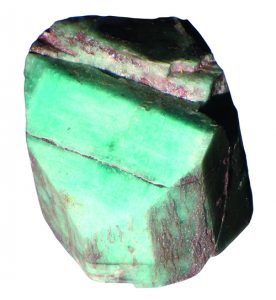
By Steve Voynick
It is sometimes easy to forget such common rock-forming minerals as the feldspars. But this group of 20 closely related species deserves a closer look.
As the most abundant mineral group, the feldspars comprise more than half of all crustal igneous, metamorphic, and sedimentary rocks. The feldspars weather into the clays that are vital moisture-retaining components of agricultural soils.
Abundant and Industrial
Some feldspar minerals are also major industrial commodities. Twenty million tons of feldspars worth $1.4 billion are mined globally each year as raw materials for the manufacture of glass, ceramics, fiberglass, and many other products. But the feldspars have more than industrial, agricultural, and petrological importance; several are also collectible minerals and gemstones.
The name “feldspar” stems from the German feld, or “field,” and the Old High German spath, or “spar.” The literal meaning, “field stone,” alludes to the feldspars’ tendency to weather relatively quickly into soil-building clays.
All feldspar minerals share a Mohs hardness of 6.0-6.5 and a vitreous luster. As framework silicates (tectosilicates), they are structurally similar to quartz. Quartz consists of silica (silicon dioxide, SiO2) and forms the silica tetrahedron (SiO4)4-. But an aluminum ion (Al3+) often replaces a silicon ion in the (SiO4)4- tetrahedron to make the aluminosilicate tetrahedron (AlSi3O8)1-. To balance the -1 charge and achieve electrical stability, aluminosilicate tetrahedra bond ionically to the positively charged metal ions of potassium, sodium, calcium, and barium in various combinations to create the feldspar minerals.
Divisions of Feldspar

(Steve Voynick)
The two main feldspar divisions are the alkali feldspars (“potassium feldspars” or “K-feldspars”) and plagioclase feldspars. Alkali feldspars contain the alkali metals potassium and/or sodium; plagioclase feldspars contain sodium and/or calcium. Differentiating individual species often requires laboratory analysis.
The most common alkali feldspars are sanidine, orthoclase, and microcline. All share similar physical properties, but variations in the aluminum-silicon lattice positions cause them to crystallize in different systems.
The plagioclase feldspars include the common minerals albite and anorthite. The name “plagioclase,” which stems from the Greek words for “oblique” and “break,” refers to cleavage planes that intersect at other than right angles. Varying amounts of sodium and calcium create a graded solid-solution series with such intermediate plagioclase members as oligoclase, andesine, labradorite, and bytownite.
Amazonite’s Appeal
The most widely collected feldspar mineral is amazonite, the blue-green variety of microcline. Amazonite’s colors are produced when exposure to geophysical radiation deforms the lattice, creating voids called “color centers.” These color centers trap lead ions, altering the light-absorption characteristics of the microcline lattice to create green-blue colors. Composite specimens of amazonite and smoky quartz are widely collected.
The presence of albite within amazonite frequently creates a white mottling. At crystallization temperatures, microcline and albite are completely soluble. But after cooling, solubility levels decrease and these two minerals exsolve, or separate, by solid diffusion into alternating bands of blue-green amazonite and white albite.
As an accessory mineral in many pegmatite specimens, albite provides a snow-white matrix that beautifully shows off the colors and crystal shapes of the primary mineral.
Orthoclase, which crystallizes in the monoclinic system, can occur as well-developed, prismatic or tabular crystals with several types of twinning. Orthoclase Carlsbad twins are among the most popular and affordable of all twinned-crystal specimens.
Feldspar Gemstones
The feldspar gemstones also include moonstone, translucent forms of both albite and

microcline. Light reflecting from moonstone’s lamellar (layered) structure produces its characteristic blue-white, “moon-like” sheen.
Transparent, champagne-colored crystals of orthoclase and bytownite are faceted into collector gems. Aventurine feldspar, or “sunstone,” is translucent oligoclase containing tiny muscovite or hematite inclusions that create, respectively, a green and orange glitter.
Arguably the most distinctive feldspar gemstone is labradorite, an intermediate member of the plagioclase solid-solution series. Labradorite’s twinned lamellae structure creates light interference and labradorescence, the latter a distinctive play of bright, spectral blue-green-gold colors.
So while the feldspars are common rock-forming minerals, soil-builders, and industrial commodities, they should also be remembered for their collectible specimens and gemstones.












